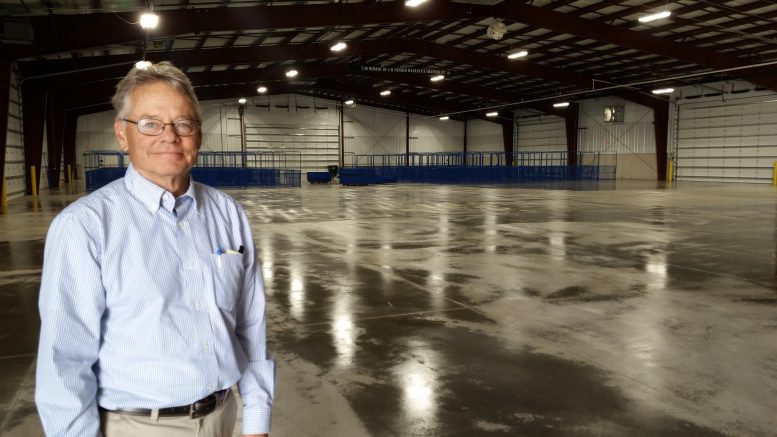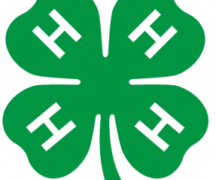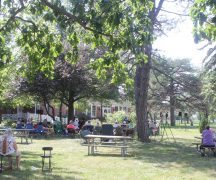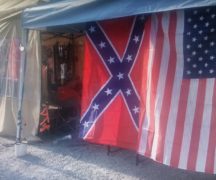By JAN LARSON McLAUGHLIN
BG Independent News
The history of the Wood County Fair has been recorded since its debut in 1851. In years to come, the history of the 2018 fair will undoubtedly note the disappearance of the old livestock barns and show arena – replaced with a shiny new $2.2 million building.
“It feels good that we’re to the point of completion,” said Steve Speck, president of the Wood County Fair Foundation. “There have been countless hours put in by the foundation to work on the details.”
Speck presented a program on the new fair exhibition building Thursday to the Bowling Green Kiwanis. But first, retired 4-H agent Dick Martin set the scene with a bit of fair history.
The first Wood County Fair was held in a grove of trees north of Wooster Street, between Church and Grove streets.
After 1851, the Wood County Fair jumped around from Bowling Green, to Perrysburg, to Portage, to Tontogany, and back again many times. In fact, for a series of years it was held in two towns because of warring fair factions.
The county fair was, for many, the event of the year. It attracted families in their best clothing for food, music and competitions. Some records show that the Wood County Fair had the second highest attendance of any county fairs in the state.
In 1882, the area currently used as Bowling Green City Park was purchased for the fair. Among the first buildings constructed were Needle Hall, Veterans Building, the Depot, and Girl Scout Building – which was formerly called the Women’s Christian Temperance Building, Martin said.
The county fair often represented the times. In 1854, a cholera outbreak drastically cut attendance, in 1896 a group of “hoochie-coochie” dance girls stirred up trouble, and in 1962 ostrich races were held. In 1883, fairgoers could purchase side tickets to watch the hanging of Carl Bach, who murdered his wife with a corn knife.
In the late 1920, the H.J. Heinz Co. put on pressure to change the fair date so it didn’t conflict with tomato harvest, because the company couldn’t find enough employees to show up at work to bottle the ketchup during the fair.
“The fair was pretty big stuff,” Martin said. During its heyday, the county fair was said to have set a record attendance of 21,000 in one day.
But when the economy tanked in the 1920s, the fair suffered. A tax levy was put on the ballot to support the fair – but it was voted down 5 to 1.
Then the night before the 1927 fair was to open, a horse barn on the fairgrounds burned down.
“For 23 years, we had no fair,” Martin said.
A few harvest festivals were held in the area, but no more county fair – until 1951 when a group revived the tradition. In 1953, the current fairgrounds property was purchased.
“We owe a debt of gratitude to the men and women who got that started again,” Martin said.
Newspaper articles from early fairs indicated some concerns about the lively – even immoral – nature of the events.
“The ‘coochie coochie’ dancers were also decidedly immoral and not only men visited them, but boys scarcely in their teens who had the necessary dime,” a newspaper stated. “Seeds of immorality were sown that will bear noxious fruit in the minds of the young.”
The fair occasionally brought out the worse in both genders. One account reported, “A couple of well-dressed married women residing near town engaged in a lively fight just outside the fairgrounds this afternoon. One used her fist and the other a parasol. The husband of the most pugilistic one stood by and watched the old woman do the other one up. Some very choice language was used.”
“Never before in the history of the county was such a fair held here,” one story reported. “It amounted to nothing more or less than a show of immorality. There were skin games of all sorts and an army of crooks, thieves and pickpockets that preyed upon the public.”
The oldest artifact known in existence from the county fair is a first place certificate from 1852 – for the best rat trap, Martin said.

Interior of 42,500-square-foot building.
Years from now, historians will no doubt write about this year’s fair, with the opening of the new exhibition building.
“There are so many, many pieces, but it comes together,” Speck said of the annual fair that starts this year on July 30.
With the enrollment of FFA and 4-H members ranking in the top five counties in the state, the 42,500-square-foot building will be put to good use. The new structure takes the place of five older barns that were suffering from years of use, Speck said.
The north end of the building will be able to house about 300 hogs. The south end will be able to handle 270 to 280 cattle. And in the middle of the pavilion will be the show arena.
“It’s really good and satisfying that we’re there,” Speck said.
He realizes that some people accustomed to the old barns are anxious about the new facility.
“It will be nice to get through the first fair and work out some of the bugs for the next year,” Speck said.
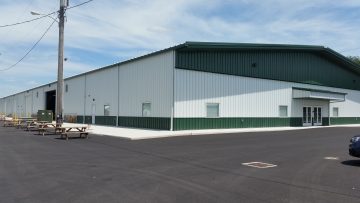
Building’s exterior
In addition to the livestock areas of the building, the facility also has a finished meeting room that can accommodate at least 100 people. There is a catering prep area, plus the entire site is equipped with heat and air conditioning.
The building will truly be a multi-purpose barn, Speck said.
“It’s something that can be used by the community more than just one week of the fair,” he said.
The fair board is hoping the building will be rented out for meetings, receptions, even trade shows. It was already used earlier this year for a “Shipshewana on the Road” show.
Fair officials will be working with the Bowling Green Chamber of Commerce on future uses of the site.
“We’re pretty excited about that,” he said.
The project has been built with great community support, including a gift of nearly $500,000 by Doug and Mary Ellen Pratt, in honor of Fred Pratt, a former member of the ag board.
So far, $1.7 million has been raised, with about $500,000 still needed, Speck said.

